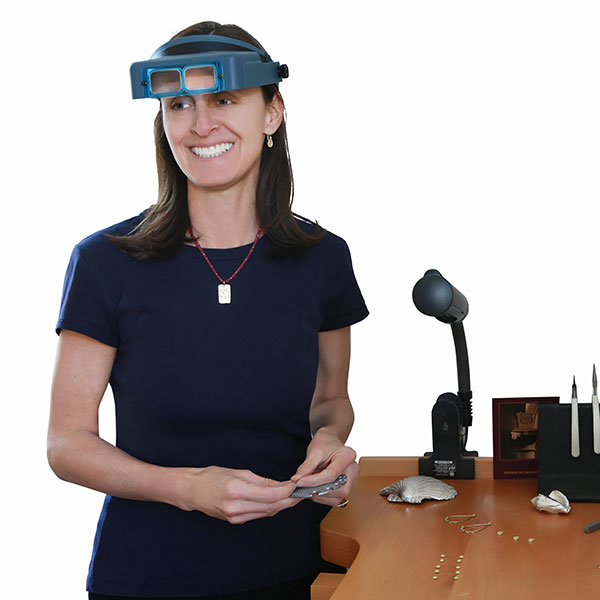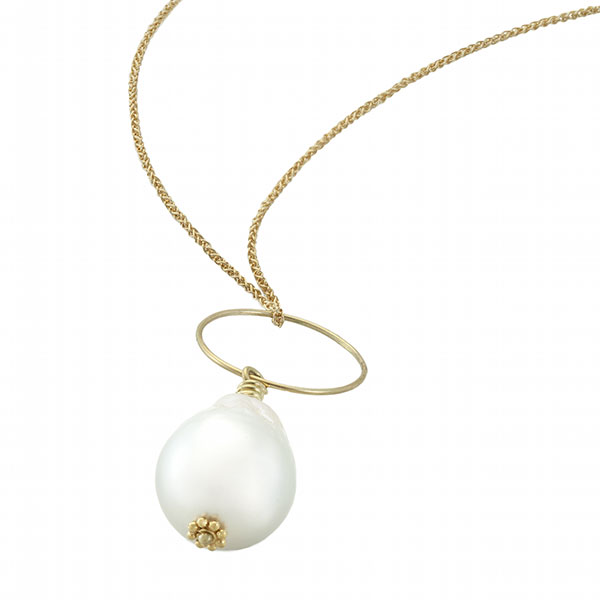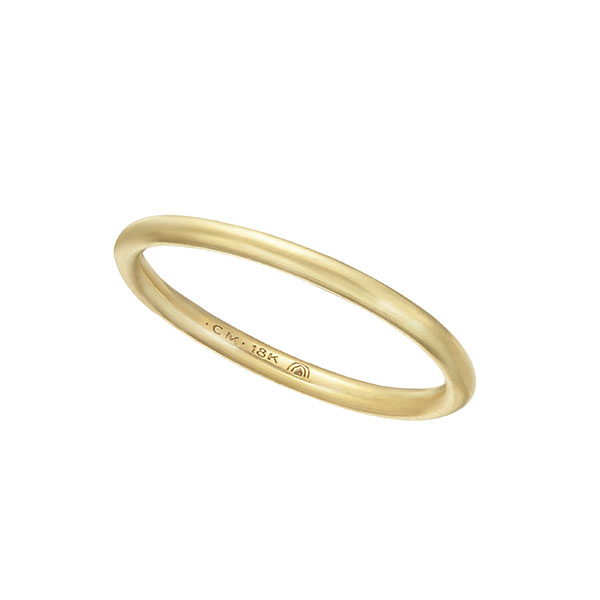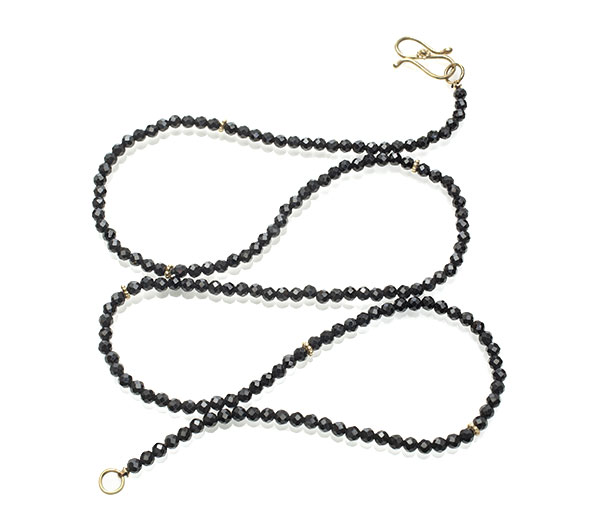
Twenty years ago, Christina Malle was a human rights attorney doing pro bono work for asylum seekers in New York City when she strolled past the 92Y, near her home on Manhattan’s Upper East Side, and glimpsed a sign advertising “goldsmithing for absolute beginners.”
“To be able to make something beautiful from a mound of raw materials was really inspiring,” says Malle (pictured). “And I loved the idea of creating a treasure that people in the future would value and hold dear.”
Malle signed up for the course (New York City-based master goldsmith Donna Distefano was her first teacher). As she honed her bench skills and earned her graduate gemologist degree from GIA, Malle continued to represent asylum seekers and practice immigration law. In 2007, however, she decided to pursue jewelry full-time.
In the 14 years since, Malle has invested her time and resources into creating a responsible jewelry practice. She serves on the board of directors of Ethical Metalsmiths and on the events committee and the board of the NY Metro chapter of the Women’s Jewelry Association.
Malle is among the industry’s biggest advocates for traceability and transparency in the jewelry supply chain. When possible, she uses materials whose origins can be documented. When she doesn’t know how a material was sourced, she is up front about that with her customers.
A portion of Malle’s collection is made in traceable Fairmined gold (she became an official Fairmined Licensee in 2019).

Recently, Malle spoke to JCK about why she works with Fairmined gold, what she thinks of recycled material, and how she reconciles her lofty goals with the complicated reality of gold sourcing.
“I ask a lot of questions,” she says. “And maybe because of my training as an attorney, I feel really entitled to answers.”
How did you get interested in Fairmined Gold?
About three years ago, at the Chicago Responsible Jewelry Conference, I saw the film River of Gold. Anyone who walks away from that film feels despair. Instead of feeling helpless, I felt I had to do something.
At the conference, there was a gentleman named Roberto, who was speaking about a mine in Colombia that had been Fairmined certified and how that certification helped his community. They were learning techniques to use less mercury. Also, the premium attached to Fairmined helped them mitigate environmental damage.
There are many ways to help a mining community have a better impact. (They could require better cell phone connections to keep up with London gold prices.) Here was someone from a mine telling me what miners could use to do better. It was a really eye-opening experience to think of the other side of the supply chain: Where is my gold from? How do I know? And what can I do to be part of a positive, or even a neutral, system?
What portion of your collection is made in Fairmined gold?
I don’t only use Fairmined gold—it’s a small percentage (maybe 20 to 25%)—but I can produce almost any piece in Fairmined on request. I want to make sure I don’t mingle Fairmined and non-Fairmined. Wedding bands are easy because at the point of engagement, there’s a heightened awareness of “I want this to be beautiful in every way.”

I would love to do my whole line in Fairmined—that’s a goal. But really what I would love is for the whole gold supply chain to be traceable. It’s the opacity and murkiness I find so frustrating. How are we going to do better if we don’t even know what we’re dealing with?
Fairmined is not the only answer. It’s a partial contribution to a better system. And the only way I can easily access traceable gold.
Where do your source your Fairmined Gold?
I love Hoover & Strong, where I buy Fairmined. They are secondary refiners. But people operating in the primary refining world are the choke point, part of this whole system of opacity.
Anyone can buy Fairmined, they just can’t use the logo unless they’re certified. And it’s just a bit more expensive than [non-Fairmined gold]—about 10 to 15% more. People who buy in volume probably don’t pay as much. The premium is from the tracing and tracking, which definitely requires a large investment from refiners.
I feel there’s also a price we are all collectively paying for the status quo. There is harm to people and the planet if we underpay people for their fair labor. I understand we’re all running businesses, we’re not nonprofits, but we are all paying the price, through things like unrest around the world.
What do you know about the source of your non-Fairmined gold?
The other source of my gold is United Precious Metal, near Buffalo [N.Y.]. I’m dying to do a field trip up there. It would be so interesting to get a bunch of big-picture thinkers up there. They are a major supplier to jewelry people. A lot of casters on 47th Street get their gold from United Precious Metal. They sent me documentation that their 24k casting grains are certified as recycled by SCS. But what about everything else they sell?

What do you make of recycled gold, a hot topic of late?
Of course, everyone would rather use a product that’s already had a life. I love it when a client says, “Here’s a ring my father had in the ’70s, and I want to have something that touched his skin.”
But unless you’re repurposing or recycling the gold yourself, telling you it’s recycled is almost meaningless. United might have gotten gold from a bullion bar sitting in the bank. But that bar could have been brought from Switzerland—and illegally transferred from Zimbabwe to Dubai to Switzerland. It’s almost a meaningless thing.
The LBMA is saying their definition of recycled is very loose, and if you are a clever gold smuggler, all you need to do is make some bangles out of it, and suddenly it looks like jewelry. [The term recycled] is so meaningless—if you can’t trace and track it, the term doesn’t have any teeth to it.
You mentioned that you took the word responsible off your website. Why is that?
We’re all consumers of gold, and unless we can actively be part of a traceable and trackable system, we’re all complicit.
So many of us want to add beauty to the world, it can be very discordant between our goals and what’s actually happening. I just try to know my vendors, trace my supplies as far as I can, try to do no harm, and if I can contribute to some good, all the better.
Top: Photo by Stef Halmos
- Subscribe to the JCK News Daily
- Subscribe to the JCK Special Report
- Follow JCK on Instagram: @jckmagazine
- Follow JCK on X: @jckmagazine
- Follow JCK on Facebook: @jckmagazine







